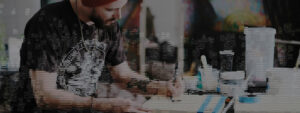Table of Contents
- Why Social Media Matters for Artists and Designers
- Understanding Your Audience: Who Are You Creating For?
- Choosing the Right Platforms: Where Should You Be?
- Creating Compelling Visual Content: The Power of Storytelling
- Building Your Brand Identity: Be Unapologetically You
- Engaging with Your Audience: It’s All About Connection
- Leveraging Analytics for Success: Data-driven Decisions
- Overcoming Challenges and Pitfalls
- Conclusion
Why Social Media Matters for Artists and Designers

As artists and designers, our work is deeply personal. It’s an expression of who we are, our passions, and our unique perspective on the world. But what good is all that creativity if nobody sees it? That’s where social media comes in.
Today’s social media platforms like Instagram, Pinterest, Artstation, and Behance have become the go-to places for discovering new talent and connecting with like-minded individuals. These platforms offer us a chance to showcase our work to a global audience, network with other creatives, and even sell our art directly to fans.
There are downsides to social media for artists.
- Does it take too much time away from your artwork?
- Does the idea of marketing and networking make you feel nauseous?
If social media feels like an obstacle to your creativity, consider exploring alternative marketing methods.
As a creative, it’s crucial to determine what works best for you and your art.
Understanding Your Audience: Who Are You Creating For?
Before you start posting content on social media, it’s crucial to understand who your audience is. Are you creating for fellow artists, potential clients, or art enthusiasts? Knowing your audience will help you tailor your content to resonate with them and build a loyal following.
For example, if you’re a digital illustrator specializing in fan art, your audience might consist of pop culture enthusiasts and fellow fans of the franchises you love. In this case, you’ll want to create social media content that showcases your passion for these subjects while also adding your unique artistic flair.
How do you find your target audience, you might ask? The answer to that is research! There are several methods you can use to gather all the details about your target audience.
- Research Competitor Audiences: You and your direct competitors often target the same audience, so understanding your competitors’ audience could help you define your own.
- Use Internal Analytics: If you have an established website and set up Google Analytics, more than likely you have a history of real user data that you can analyze at your fingertips.
- Analyze Social Media Data: The majority of social media apps have their analytics built in, allowing you to learn about your follower’s demographics.
Conduct Surveys: Using surveys is an efficient method to collect and evaluate audience feedback on a large scale. If you have a CRM tool on your website, like Hubspot, you can easily set up a survey page or send off an email asking for feedback.
Choosing the Right Platforms: Where Should You Be?
With so many social media platforms out there, it can be overwhelming to decide where to focus your efforts. Each platform has its strengths and weaknesses, so it’s essential to choose the ones that align with your goals and target audience.
For visual artists and designers, platforms like Instagram, Pinterest, and Behance are absolute musts.
- Instagram is perfect for sharing your latest works in a visually appealing way.
- Pinterest is great for curating inspiration boards and driving traffic to your portfolio.
- Behance, on the other hand, is a fantastic platform for showcasing your professional portfolio and connecting with potential clients and collaborators.
If you have certain goals in mind for your social media marketing strategy, it’s important to take them into account. For example, if you are using social media to sell your artwork then you might consider Instagram’s shopping feature or TikTok Shop to reach those goals.
Creating Compelling Visual Content: The Power of Storytelling
As artists and designers, we’re storytellers at heart. Whether we’re creating a detailed illustration, a stunning photograph, or a sleek logo design, there’s always a story behind our work. And social media is the perfect medium for sharing those stories with the world.
When creating content for social media, focus on telling stories that resonate with your audience. Share behind-the-scenes glimpses of your creative process, highlight the inspiration behind your latest piece, or even share personal anecdotes that give your followers a glimpse into your life as an artist.
Building Your Brand Identity: Be Unapologetically You
In a sea of endless content, it’s essential to stand out and make a lasting impression. That’s where branding comes in. Your brand identity is what sets you apart from other artists and designers and gives your work a recognizable and memorable presence online.
Take some time to define your brand identity and establish a consistent visual style across all your social media platforms. Whether it’s through your choice of colors, typography, or subject matter, make sure that every piece of content you share reflects who you are as an artist.
To understand more about personal branding, check out: “The Power of Personal Branding: Building Your Professional Identity”.
Engaging with Your Audience: It's All About Connection
One of the most powerful aspects of social media is its ability to foster meaningful connections with your audience. Don’t just treat social media as a one-way street where you’re constantly pushing out content. Instead, make an effort to engage with your followers, respond to comments and messages, and foster a sense of community around your work.
When I first started using Instagram as a platform to share my work, I was amazed by the sense of camaraderie I found within the art community. By engaging with other artists’ posts, leaving thoughtful comments, and participating in challenges and collaborations, I was able to forge genuine connections and expand my network in ways I never thought possible.
Leveraging Analytics for Success: Data-driven Decisions
Don’t underestimate the power of analytics when it comes to growing your presence on social media. Most platforms offer built-in analytics tools that provide valuable insights into your audience demographics, engagement metrics, and content performance.
Pay attention to which types of posts resonate most with your audience, what times of day your followers are most active, and which hashtags are driving the most engagement. Use this data to refine your content strategy and optimize your social media presence for maximum impact.
Overcoming Challenges and Pitfalls
Social media can be a double-edged sword for artists and designers. While it offers incredible opportunities for exposure and connection, it also comes with its fair share of challenges and pitfalls. Here’s how you can navigate some of the most common obstacles:
Dealing with Algorithm Changes and Platform Updates
One of the biggest frustrations for artists and designers on social media is the ever-changing algorithms and platform updates. Just when you think you’ve cracked the code and figured out what works best for your content, the rules change, and your engagement takes a hit.
The key to dealing with algorithm changes is adaptability. Stay informed about updates to the platforms you use most frequently, and be prepared to adjust your strategy accordingly. Experiment with different types of content, posting times, and engagement tactics to see what resonates best with your audience in the current algorithmic landscape.
Remember, it’s not personal. Algorithm changes affect everyone on the platform, not just you. Stay focused on creating quality content and engaging with your audience authentically, and the rest will fall into place.
Handling Negative Feedback and Criticism
No matter how talented you are or how beautiful your work may be, you’re bound to encounter negative feedback and criticism at some point on social media. It’s just a fact of life in the digital age.
When faced with negativity online, it’s essential to approach it with grace and professionalism. Resist the urge to lash out or engage in arguments with trolls. Instead, take a step back, breathe, and consider whether there’s any validity to the criticism. If so, use it as an opportunity for growth and self-improvement. If not, simply brush it off and move on.
Remember, you can’t please everyone, and that’s okay. Focus on the positive feedback and constructive criticism from your genuine fans and supporters, and don’t let the haters get you down.
Maintaining Authenticity and Avoiding Burnout
Social media is fast-paced. It’s easy to get caught up in the pressure to constantly churn out content and keep up with the latest trends. But if you’re not careful, this relentless pursuit of perfection can quickly lead to burnout and a loss of authenticity.
To avoid burnout and stay true to yourself as an artist or designer, prioritize self-care and set boundaries for your social media use. Take breaks when you need them, and don’t be afraid to step away from the screen and recharge your creative batteries.
Remember why you started creating art in the first place and hold onto that passion and enthusiasm. Share your journey authentically with your audience, including the highs and lows, and don’t be afraid to show your vulnerable side. Your authenticity is what will ultimately resonate most with your audience and keep them coming back for more.
In the end, social media is just a tool—a means to an end, not the end itself. Don’t let it consume you or define your worth as an artist or designer. Stay true to yourself, keep creating from the heart, and the rest will fall into place.
Final Thoughts
In conclusion, social media has revolutionized the way artists and designers connect with their audience and share their work with the world. By understanding your audience, choosing the right platforms, creating compelling content, building your brand identity, engaging with your audience, and leveraging analytics, you can take your social media game to the next level and turn your passion into a thriving online presence.
So, what are you waiting for? It’s time to unleash your creativity, embrace the power of social media, and take your art and design career to new heights.



